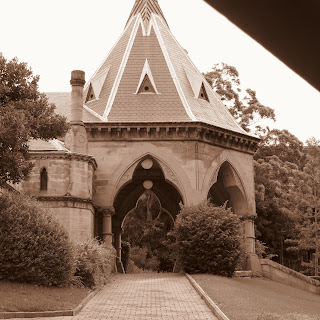Mortuary Station - Central - Chippendale
Chippendale station, sandwiched between Sydney’s Central Station and Railway Square, originally opened as Mortuary Station on June 29, 1869, and was used to transport the dead and their grieving relatives to their final resting place, Rookwood Cemetery.
Adorned with angels, cherubs and gargoyles, the Venetian 13th century Gothic-style building was designed by James Barnet as a central stop to pick up the dead and their living families. Those families had to pay for their return tickets on the grave-y train, but the dead — I imagine due to their inability to access their wallet — generously rode free.
Apparently, the train timetable saw two trains leaving a day — one in the morning and one in the afternoon. On board, there were two types of hearse carriages used to transport the dead. The largest could hold up to 30 coffins, while the other could fit 10 at most. Mourners were held in a separate area of the train, and all disembarked at an almost identical station at the other end, aptly named Cemetery Station.
The station and train line were in use until 1947, when the last railway timetable was recorded. It read, “Sydney 2.17pm to Strathfield 2.33pm to Rookwood #1, 2.50pm." By that time, roads were in better shape and cars were a much more popular mode of transport. As such, most funeral processions travelled by car and the need for Mortuary Station was no more. It’s Rockwood sister, Cemetery Station, was dismantled in the '50s and actually rebuilt stone for stone in Canberra to become the All Saints Church. But good ol’ Morty still stands, and if its walls could talk, they’d have a lot to say about its colourful life since those dark early days.
In the 1950s, it became a depot to dispatch animals, namely horses, then moved into a new role as a parcel depot, before taking on its most ambitious role as a pancake restaurant in the '80s. That’s right, from 1986-89, two men by the name of Peter Shield and John McNally had the sweet idea of taking the original railway carriages and turning them into dining areas to eat breakfast. I don’t know about you, but nothing makes me hungrier than thinking about dead people. Know what I mean? Pass the syrup, please.
the restaurant flopped, and by 1989 it was a ghost town once more. Over the last 25 odd years, it’s been refurbished, heritage listed, vandalised and used as a wedding location. Because that’s the other thing thinking about the dead makes me want to do: marry the one I love
JANUARY 2022
The Redfern Mortuary Station, also known as the Mortuary Railway Station, is a historic railway station in Sydney, Australia. It served as a terminal station specifically designed for transporting the deceased and mourners to and from Rookwood Cemetery, one of the largest cemeteries in the Southern Hemisphere. Here's an overview of the history of the Redfern Mortuary Station:
Origins and Purpose:
- The Redfern Mortuary Station was opened in 1869. It was built to cater to the growing need for a dignified and efficient means of transporting the deceased from Sydney to the more remote Rookwood Cemetery.
- At the time, the state of urban cemeteries was becoming increasingly crowded and unsanitary, leading to the establishment of larger cemeteries outside the city.
Architectural Design:
- The station was designed by colonial architect James Barnet, known for his role in designing many of Sydney's notable buildings.
- The architectural style of the station was Gothic Revival, characterized by pointed arches, ornamental details, and other features reminiscent of medieval architecture.
Functionality:
- The Redfern Mortuary Station featured covered platforms for the arrival and departure of funeral trains. It also included waiting rooms for mourners and facilities for the transfer of coffins.
- The design aimed to provide a dignified and solemn atmosphere for the transportation of the deceased and their families.
Funeral Services:
- The station was primarily used for funeral services and transporting the deceased to Rookwood Cemetery. Special funeral trains would carry coffins and mourners to the cemetery for burial.
- The station's proximity to the main line ensured easy access to the cemetery, which was located a few kilometers away.
Decline and Closure:
- With changes in funeral practices and urban development, the use of the Redfern Mortuary Station declined over the years.
- The station officially closed to funeral services in 1938, as motor hearses became more common and modern transportation methods were preferred.
Preservation and Heritage Status:
- The Redfern Mortuary Station was recognized for its historical and architectural significance. It was listed on the New South Wales State Heritage Register, ensuring its preservation for future generations.
- The station's distinctive Gothic architecture and its association with Victorian-era funeral practices make it a unique and historically important site.
Modern Use:
- While the Redfern Mortuary Station no longer serves its original purpose, efforts have been made to repurpose and restore the station for various uses.
- The station occasionally hosts cultural events, exhibitions, and tours, allowing visitors to explore its architectural beauty and learn about its history.
The Redfern Mortuary Station stands as a reminder of a bygone era and provides insight into the customs and practices of the past. Its architectural significance, along with its association with Sydney's funeral history, adds to its cultural and historical value in the city's landscape.





































